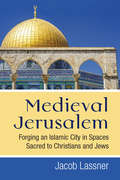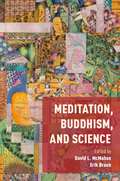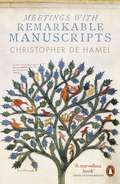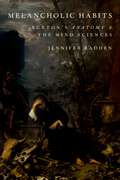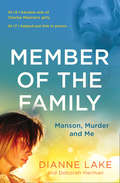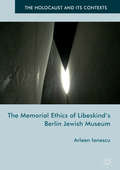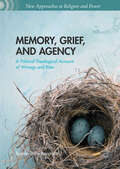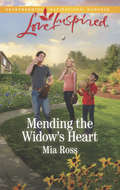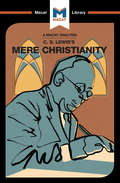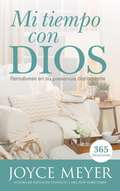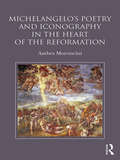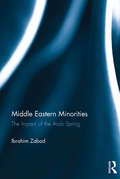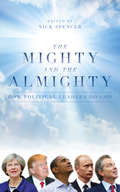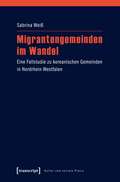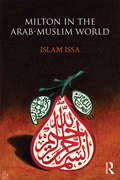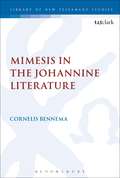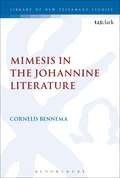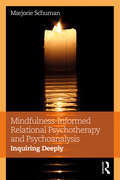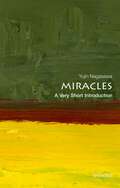- Table View
- List View
Medieval Jerusalem: Forging an Islamic City in Spaces Sacred to Christians and Jews
by Jacob LassnerMedieval Jerusalem examines an old question that has recently surfaced and given rise to spirited discussion among Islamic historians and archeologists: what role did a city revered for its holiness play in the unfolding politics of the early Islamic period? Was there an historic moment when the city, holy to Jews, Christians, and Muslims, may have been considered as the administrative center of a vast Islamic world, as some scholars on early Islam have recently claimed? Medieval Jerusalem also emphasizes the city’s evolution as a revered Islamic religious site comparable to the holy cities Mecca and Medina. Examining Muslim historiography and religious lore in light of Jewish traditions about the city, Jacob Lassner points out how these reworked Jewish traditions and the imposing monumental Islamic architecture of the city were meant to demonstrate that Islam had superseded Judaism and Christianity as the religion for all monotheists. He interrogates the literary sources of medieval Islamic historiography and their modern interpreters as if they were witnesses in a court of law, and applies the same method for the arguments about the monuments of the city’s material culture, including the great archaeological discoveries along the south wall of the ancient Temple Mount. This book will be of interest to a broad range of readers given the significance of the city in the current politics of the Near East. It will in part serve as a corrective to narratives of Jerusalem’s past that are currently popular for scholarly and political reasons.
MEDITATION, BUDDHISM & SCIENCE C
by Erik Braun David L. McMahanThe scientific study of Buddhist forms of meditation has surged in recent years, capturing the popular imagination and reshaping conceptions of what meditation is and what it can do. For perhaps the first time in history, meditation has shifted from Buddhist monasteries and practice centers to some of the most prominent and powerful modern institutions in the world, as well as non-institutional settings. As their contexts change, so do the practices-sometimes drastically. New ways of thinking about meditation are emerging as it moves toward more secular settings, ways that profoundly affect millions of lives all over the world. To understand these changes and their effects, the essays in this volume explore the unaddressed complexities in the interrelations between Buddhist history and thought and the scientific study of meditation. The contributors bring philosophical, cultural, historical, and ethnographic perspectives to bear, considering such issues as the philosophical presuppositions behind practice, the secularization of meditation, the values and goods assumed in clinical approaches, and the sorts of subjects that take shape under the influence of these transformed and transformative practices-all the more powerful for being so often formulated with the authority of scientific discourse.
Meetings with Remarkable Manuscripts: Twelve Journeys Into The Medieval World
by Christopher De Hamel'An endlessly fascinating and enjoyable book' Neil MacGregor'Full of delights' Tom StoppardAn extraordinary exploration of the medieval world - the most beguiling history book of the yearThis is a book about why medieval manuscripts matter. Coming face to face with an important illuminated manuscript in the original is like meeting a very famous person. We may all pretend that a well-known celebrity is no different from anyone else, and yet there is an undeniable thrill in actually meeting and talking to a person of world stature.The idea for the book, which is entirely new, is to invite the reader into intimate conversations with twelve of the most famous manuscripts in existence and to explore with the author what they tell us about nearly a thousand years of medieval history - and sometimes about the modern world too. Christopher de Hamel introduces us to kings, queens, saints, scribes, artists, librarians, thieves, dealers, collectors and the international community of manuscript scholars, showing us how he and his fellows piece together evidence to reach unexpected conclusions. He traces the elaborate journeys which these exceptionally precious artefacts have made through time and space, shows us how they have been copied, who has owned them or lusted after them (and how we can tell), how they have been embroiled in politics and scholarly disputes, how they have been regarded as objects of supreme beauty and luxury and as symbols of national identity. The book touches on religion, art, literature, music, science and the history of taste.Part travel book, part detective story, part conversation with the reader, Meetings with Remarkable Manuscripts conveys the fascination and excitement of encountering some of the greatest works of art in our culture which, in the originals, are to most people completely inaccessible. At the end, we have a slightly different perspective on history and how we come by knowledge. It is a most unusual book.
Melancholic Habits: Burton's Anatomy & the Mind Sciences
by Jennifer RaddenJennifer Radden here provides a re-interpretation of the classic text by 17th century scholar Robert Burton, The Anatomy of Melancholy. Her new reading of Burton's essential text brings several key facets of his thought to light: the role of imagination in inciting and averting melancholy as disorder; the part played by daily habits of thought in engendering severe and incurable conditions; the multi-directional feedback loops linking feeling and thought in his model of mind; and an emphasis on symptoms and natural history in his understanding of disease. Much of Burton's account is derived from classical, medieval and renaissance writing about melancholy, yet he brought them together into something new: an account that -- while it stands in contrast to many of the assumptions of later psychology -- concurs surprisingly well with present day cognitivism. Moreover, although seventeenth century melancholy bears only a loose relationship to present day mood disorders such as depression and anxiety, on this reading the Anatomy anticipates a considerable number of findings and hypotheses associated with present day psychiatry, including its network models of depression, for example, and its emphasis on the part played by rumination and mind wandering in engendering affective disorder. Radden's new reading of a classic text should interest readers in philosophy of mind and psychiatry, clinical psychiatry and the history of medicine.
Member of the Family: Manson, Murder And Me
by Dianne LakeFollowing the recent death of Charles Manson – the leader of the sinister 60s cult – Dianne Lake reveals the true story of life with Manson and his ‘family’, who became notorious for a series of shocking murders during the summer of 1969.
The Memorial Ethics of Libeskind's Berlin Jewish Museum (The Holocaust and its Contexts)
by Arleen IonescuThis book is a detailed critical study of Libeskind’s Berlin Jewish Museum in its historical, architectural and philosophical context. Emphasizing how the Holocaust changed our perception of history, memory, witnessing and representation, it develops the notion of ‘memorial ethics’ to explore the Museum’s difference from more conventional post-World War Two commemorative sites. The main focus is on the Museum as an experience of the materiality of trauma which engages the visitor in a performative duty to remember. Arleen Ionescu builds on Levinas’s idea of ‘ethics as optics’ to show how Libeskind’s Museum becomes a testimony to the unpresentable Other. Ionescu also extends the Museum’s experiential dimension by proposing her own subjective walk through Libeskind’s space reimagined as a ‘literary museum’. Featuring reflections on texts by Beckett, Celan, Derrida, Kafka, Blanchot, Wiesel and Selma Meerbaum-Eisinger (Celan’s cousin), this virtual tour concludes with a brief account of Libeskind’s analogous ‘healing project’ for Ground Zero.
Memory, Grief, and Agency: A Political Theological Account of Wrongs and Rites (New Approaches to Religion and Power)
by Sunder John BoopalanThis book argues that an active memory of and grief over structural wrongs yields positive agency. Such agency generates rites of moral responsibility that serve as antidotes to violent identities and catalyze hospitable social practices. By comparing Indian and U.S. contexts of caste and race, Sunder John Boopalan proposes that wrongs today are better understood as rituals of humiliation which are socially conditioned practices of domination affected by discriminatory logics of the past. Grief can be redressive by transforming violent identities and hostile in-group/out-group differences when guided by a liberative political theological imagination. This volume facilitates interdisciplinary conversations between theorists and theologians of caste and race, and those interested in understanding the relation between religion and power.
Mending The Widow's Heart: Amish Christmas Twins An Alaskan Christmas Mending The Widow's Heart (Liberty Creek #1)
by Mia RossThe Widow’s New Beginning
Mere Christianity (The Macat Library)
by Mark ScarlataC.S. Lewis’s Mere Christianity is a perfect example of one of the most effective aspects of critical thinking skills: the use of reasoning to build a strong, logical argument. ¶Lewis originally wrote the book as a series of radio talks given from 1942-1944, at the height of World War II. The talks were designed to lay out the most basic tenets of Christianity for listeners, and to use these to make a logical argument for Christian belief and Christian ethics. While Lewis was not an academically-trained theologian or philosopher (specializing instead in literature), his own experience of converting from atheism to Christianity, along with his wide reading and incisive questioning, power a charming but persuasive argument for his own beliefs. ¶Whether or not one agrees with Lewis’s arguments or shares his faith, Mere Christianity exemplifies one of the most useful aspects of good reasoning: accessibility. When using reasoning to construct a convincing argument, it is crucial that your audience follow you, and Lewis was a master at constructing well-organised arguments that are immediately understandable to readers. The beautifully written Mere Christianity is a masterclass in cogently walking an audience through an elegant and well thought-through piece of reasoning.
Mere Christianity (The Macat Library)
by Mark ScarlataC.S. Lewis’s Mere Christianity is a perfect example of one of the most effective aspects of critical thinking skills: the use of reasoning to build a strong, logical argument. ¶Lewis originally wrote the book as a series of radio talks given from 1942-1944, at the height of World War II. The talks were designed to lay out the most basic tenets of Christianity for listeners, and to use these to make a logical argument for Christian belief and Christian ethics. While Lewis was not an academically-trained theologian or philosopher (specializing instead in literature), his own experience of converting from atheism to Christianity, along with his wide reading and incisive questioning, power a charming but persuasive argument for his own beliefs. ¶Whether or not one agrees with Lewis’s arguments or shares his faith, Mere Christianity exemplifies one of the most useful aspects of good reasoning: accessibility. When using reasoning to construct a convincing argument, it is crucial that your audience follow you, and Lewis was a master at constructing well-organised arguments that are immediately understandable to readers. The beautifully written Mere Christianity is a masterclass in cogently walking an audience through an elegant and well thought-through piece of reasoning.
Mi Tiempo Con Dios: Renuévese en su presencia diariamente
by Joyce MeyerEn su devoción más personal, Joyce Meyer ofrece un camino para que usted desarrolle una mayor cercanía con Dios. Escrito durante un período de tres años, estos estímulos fueron revelados a Joyce a través de sus propias experiencias, e inspirados en su corazón para ayudarlo a acercarse a Dios a través de su tiempo devocional con Él.La cosa más importante que Joyce quiere que sepa es que Dios le ama completamente y quiere una relación cercana y personal con usted. MI TIEMPO CON DIOS le inspirará a pasar más tiempo con Dios y Su Palabra. Es un recurso eficaz para ayudarle a lograr la sensación de paz y felicidad que cambia la vida y que sólo proviene de la cercanía con Él. Lleno de Escrituras, poderosos consejos y oraciones, cuando saca tiempo cada día para leer y estudiar este devocional, comenzará a experimentar una intimidad fresca y poderosa con nuestro Señor.
Mi Tiempo Con Dios: Renuévese en su presencia diariamente
by Joyce MeyerOver the course of three years, Joyce Meyer recorded in her journal the personal devotions and inspirations that guided her busy life. Those writings comprise My Time With God, the 365-day devotional that shares powerful insight into Joyce's spiritual reflections and journey. Each daily entry guides readers through a narrative of meditations, an uplifting declaration, and relevant scripture to encourage greater intimacy with God. Including spiritual revelations experienced by one of the world's leading Bible teachers, this book will renew readers' minds, offering assurance of God's complete love and desire for closeness with them.
Michelangelo's Poetry and Iconography in the Heart of the Reformation
by Ambra MoronciniContextualizing Michelangelo’s poetry and spirituality within the framework of the religious Zeitgeist of his era, this study investigates his poetic production to shed new light on the artist’s religious beliefs and unique language of art. Author Ambra Moroncini looks first and foremost at Michelangelo the poet and proposes a thought-provoking reading of Michelangelo’s most controversial artistic production between 1536 and c.1550: The Last Judgment, his devotional drawings made for Vittoria Colonna, and his last frescoes for the Pauline Chapel. Using theological and literary analyses which draw upon reformist and Protestant scriptural writings, as well as on Michelangelo’s own rime spirituali and Vittoria Colonna’s spiritual lyrics, Moroncini proposes a compelling argument for the impact that the Reformation had on one of the greatest minds of the Italian Renaissance. It brings to light how, in the second quarter of the sixteenth century in Italy, Michelangelo’s poetry and aesthetic conception were strongly inspired by the revived theologia crucis of evangelical spirituality, rather than by the theologia gloriae of Catholic teaching.
Michelangelo's Poetry and Iconography in the Heart of the Reformation
by Ambra MoronciniContextualizing Michelangelo’s poetry and spirituality within the framework of the religious Zeitgeist of his era, this study investigates his poetic production to shed new light on the artist’s religious beliefs and unique language of art. Author Ambra Moroncini looks first and foremost at Michelangelo the poet and proposes a thought-provoking reading of Michelangelo’s most controversial artistic production between 1536 and c.1550: The Last Judgment, his devotional drawings made for Vittoria Colonna, and his last frescoes for the Pauline Chapel. Using theological and literary analyses which draw upon reformist and Protestant scriptural writings, as well as on Michelangelo’s own rime spirituali and Vittoria Colonna’s spiritual lyrics, Moroncini proposes a compelling argument for the impact that the Reformation had on one of the greatest minds of the Italian Renaissance. It brings to light how, in the second quarter of the sixteenth century in Italy, Michelangelo’s poetry and aesthetic conception were strongly inspired by the revived theologia crucis of evangelical spirituality, rather than by the theologia gloriae of Catholic teaching.
Middle Eastern Minorities: The Impact of the Arab Spring
by Ibrahim ZabadThis is a comprehensive survey of minorities in the Middle East with a special focus on the post Arab Spring era. Minority communities in the Middle East are the most susceptible to the turbulence engulfing the region; the majority may suffer physical violence and socioeconomic loss, but minorities could potentially vanish. Instead of ushering in democracy and inclusive politics, the revolutionary upheavals have prompted chaos and fear and reinforced the resurgence of Islamic fundamentalism throughout the region. Zabad uses historical sources as well as first-hand interviews to vividly describe the current status of minorities in the Middle East, explaining attitudes towards the revolutionary upheavals as well as the various strategies they used to avail themselves of the opportunities presented and to confront the risks posed. The question of ethnic, sectarian and religious minorities is situated in the context of the broader history of the region in order to explain the underlying institutional and ideological factors that caused their predicament and problematized their relationship with the majority.The book providesa rich trove of information and insights generated from ten case studies that covered the Shī‘a in Saudi Arabia, Bahrain, Lebanon and Egypt, the Druze, the Alawites, Christians and Kurds in Syria, the Copts in Egypt, and the Zaydis in Yemen.
Middle Eastern Minorities: The Impact of the Arab Spring
by Ibrahim ZabadThis is a comprehensive survey of minorities in the Middle East with a special focus on the post Arab Spring era. Minority communities in the Middle East are the most susceptible to the turbulence engulfing the region; the majority may suffer physical violence and socioeconomic loss, but minorities could potentially vanish. Instead of ushering in democracy and inclusive politics, the revolutionary upheavals have prompted chaos and fear and reinforced the resurgence of Islamic fundamentalism throughout the region. Zabad uses historical sources as well as first-hand interviews to vividly describe the current status of minorities in the Middle East, explaining attitudes towards the revolutionary upheavals as well as the various strategies they used to avail themselves of the opportunities presented and to confront the risks posed. The question of ethnic, sectarian and religious minorities is situated in the context of the broader history of the region in order to explain the underlying institutional and ideological factors that caused their predicament and problematized their relationship with the majority.The book providesa rich trove of information and insights generated from ten case studies that covered the Shī‘a in Saudi Arabia, Bahrain, Lebanon and Egypt, the Druze, the Alawites, Christians and Kurds in Syria, the Copts in Egypt, and the Zaydis in Yemen.
The Mighty And The Almighty: How Political Leaders Do God
by Nick SpencerFor a secular age, we have a lot of religious politicians.Theresa May, Vladimir Putin, Angela Merkel, even Donald Trump all profess Christianity, as did Obama, Brown, Sarkozy, Bush and Blair before them. Indeed, it is striking how many Christian Presidents and Prime Ministers have assumed the global stage over recent years. In spite of Alastair Campbell's oft- (and mis-) quoted line, 'We don't do God', it seems like we definitely do.But how sincere is this faith? Is not much of it simply window-dressing for the electorate, paste-on haloes to calm the moral majority? Conversely, how dangerous is it? If we elect our politicians to do our democratic will, do we really want them praying to God for advice?The Mighty and the Almighty looks at some of the biggest political figures of the past forty years - from Thatcher and Reagan, through Mandela and Clinton, to May and Trump - and looks at how they 'did God'. Did their faith actually shape their politics, and if so, how? Or did their politics shape their faith? And does it matter if it did?In an age when religion is more important on the global stage than anyone would have predicted fifty years ago, this book will tell you everything you want to know, and some things you won't, about how the Mighty get on with the Almighty.
Migrantengemeinden im Wandel: Eine Fallstudie zu koreanischen Gemeinden in Nordrhein-Westfalen (Kultur und soziale Praxis)
by Sabrina Weiß2013 wurde festlich die 50-Jahr-Feier koreanischer Migrationsgeschichte in Deutschland begangen. Über Religion und Migration wird viel diskutiert, dennoch ist nach wie vor wenig über die Bedingungen der Arbeitsmigration, beispielsweise die Kultur, Tradition und Selbstorganisation der Koreaner_innen in Deutschland, bekannt. Anhand koreanischer Migrantenkirchen in Nordrhein-Westfalen untersucht Sabrina Weiß die Gründung, Etablierung und den Wandel der christlichen Gemeinschaften im Kulturkontakt aus religionswissenschaftlicher Perspektive. Die Studie leistet so einen Beitrag zu Debatten über kirchliche Institutionalisierungsprozesse und religiöse Vielfalt jenseits der etablierten Großkirchen.
Milton in the Arab-Muslim World
by Islam IssaThe first full-length study of the reception of John Milton’s (1608-74) writings in the Arab-Muslim world, this book examines the responses of Arab-Muslim readers to Milton’s works, and in particular, to his epic poem: Paradise Lost. It contributes to knowledge of the history, development, and ways in which early modern writings are read and understood by Muslims. By mapping the literary and more broadly cultural consequences of the censure, translation and abridgement of Milton’s works in the Arab-Muslim world, this book analyses the diverse ways in which Arab-Muslims read and understand a range of literary and religious aspects of Milton’s writing in light of cultural, theological, socio-political, linguistic and translational issues. After providing an overview of the presence of Milton and his works in the Arab world, each chapter sheds light on how cultural and translational issues shape the ways in which Arab-Muslim readers perceive and understand the characters and motifs of Paradise Lost. Chapters outline the ways in which the figures are currently understood in Milton scholarship, before exploring how they fit into the narrative drama and theology of the poem, and their position in Islamic creed and Arab-Muslim culture. Concurrently, each chapter examines the poem’s subject matter in detail, placing particular emphasis on matters of linguistic, theological and cultural translation and accommodation. Chapter conclusions not only summarise the patterns and potentialities of reception, but point towards the practical functions of Arab-Muslim responses to Milton’s writing and their contribution to the formation of social ideas.
Milton in the Arab-Muslim World
by Islam IssaThe first full-length study of the reception of John Milton’s (1608-74) writings in the Arab-Muslim world, this book examines the responses of Arab-Muslim readers to Milton’s works, and in particular, to his epic poem: Paradise Lost. It contributes to knowledge of the history, development, and ways in which early modern writings are read and understood by Muslims. By mapping the literary and more broadly cultural consequences of the censure, translation and abridgement of Milton’s works in the Arab-Muslim world, this book analyses the diverse ways in which Arab-Muslims read and understand a range of literary and religious aspects of Milton’s writing in light of cultural, theological, socio-political, linguistic and translational issues. After providing an overview of the presence of Milton and his works in the Arab world, each chapter sheds light on how cultural and translational issues shape the ways in which Arab-Muslim readers perceive and understand the characters and motifs of Paradise Lost. Chapters outline the ways in which the figures are currently understood in Milton scholarship, before exploring how they fit into the narrative drama and theology of the poem, and their position in Islamic creed and Arab-Muslim culture. Concurrently, each chapter examines the poem’s subject matter in detail, placing particular emphasis on matters of linguistic, theological and cultural translation and accommodation. Chapter conclusions not only summarise the patterns and potentialities of reception, but point towards the practical functions of Arab-Muslim responses to Milton’s writing and their contribution to the formation of social ideas.
Mimesis in the Johannine Literature: A Study in Johannine Ethics (The Library of New Testament Studies #498)
by C. BennemaMimesis is a fundamental and pervasive human concept, but has attracted little attention from Johannine scholarship. This is unsurprising, since Johannine ethics, of which mimesis is a part, has only recently become a fruitful area of research. Bennema contends that scholars have not yet identified the centre of Johannine ethics, admittedly due to the fact that mimesis is not immediately evident in the Johannine text because the usual terminology for mimesis is missing. This volume is the first organized study on the concept of mimesis in the Johannine literature. The aim of the study is to establish that mimesis is a genuine Johannine concept, to explain its particulars and to show that mimesis is integral to Johannine ethics. Bennema argues that Johannine mimesis is a cognitive, creative process that shapes the believer's identity and behaviour within the context of the divine family. Besides being instrumental in people's moral transformation, mimesis is also a vital mechanism for mediating the divine reality to people
Mimesis in the Johannine Literature: A Study in Johannine Ethics (The Library of New Testament Studies #498)
by Prof C. BennemaMimesis is a fundamental and pervasive human concept, but has attracted little attention from Johannine scholarship. This is unsurprising, since Johannine ethics, of which mimesis is a part, has only recently become a fruitful area of research. Bennema contends that scholars have not yet identified the centre of Johannine ethics, admittedly due to the fact that mimesis is not immediately evident in the Johannine text because the usual terminology for mimesis is missing. This volume is the first organized study on the concept of mimesis in the Johannine literature. The aim of the study is to establish that mimesis is a genuine Johannine concept, to explain its particulars and to show that mimesis is integral to Johannine ethics. Bennema argues that Johannine mimesis is a cognitive, creative process that shapes the believer's identity and behaviour within the context of the divine family. Besides being instrumental in people's moral transformation, mimesis is also a vital mechanism for mediating the divine reality to people
Mindfulness-Informed Relational Psychotherapy and Psychoanalysis: Inquiring Deeply
by Marjorie SchumanMindfulness-Informed Relational Psychotherapy and Psychoanalysis: Inquiring Deeply provides a refreshing new look at the emerging field of Buddhist-informed psychotherapy. Marjorie Schuman presents a cogent framework which engages the patient at the levels of narrative, affective regulation, and psychodynamic understanding. Blending knowledge of contemporary psychoanalysis with the wisdom of Buddhist view, she examines how mindfulness can be integrated into psychodynamic treatment as an aspect of self-reflection rather than as a cognitive behavioral technique or intervention. This book explores how mindfulness as a "self-reflective awareness practice" can be used to amplify and unpack psychological experience in psychodynamic treatment. Schuman presents a penetrating analysis of conceptual issues, richly illustrated throughout with clinical material. In so doing, she both clarifies important dimensions of psychotherapy and illuminates the role of "storyteller mind" in the psychological world of lived experience. The set of reflections comprises an unfolding deep inquiry in its own right, delving into the similarities and differences between mindfulness-informed psychotherapy, on the one hand, and mindfulness as a meditation practice, on the other. Filling in an outline familiar from psychoanalytic theory, the book explores basic concepts of Self, Other, and "object relations" from an integrative perspective which includes both Buddhist and psychoanalytic ideas. Particular emphasis is placed on how relationship is held in mind, including the dynamics of relating to one’s own mind. The psychotherapeutic approach described also delineates a method for practicing with problems in the Buddhist sense of the word practice. It investigates how problems are constructed and elucidates a strategy for finding the wisdom and opportunities for growth which are contained within them. Mindfulness-Informed Relational Psychotherapy and Psychoanalysis demonstrates in clear language how the experience of Self and Other is involved in emotional pain and relational suffering. In the relational milieu of psychotherapy, "Inquiring Deeply" fosters emotional insight and catalyzes psychological growth and healing. This book will be of great interest to psychoanalytically-oriented clinicians as well as Buddhist scholars and psychologically-minded Buddhist practitioners interested in the clinical application of mindfulness.
Mindfulness-Informed Relational Psychotherapy and Psychoanalysis: Inquiring Deeply
by Marjorie SchumanMindfulness-Informed Relational Psychotherapy and Psychoanalysis: Inquiring Deeply provides a refreshing new look at the emerging field of Buddhist-informed psychotherapy. Marjorie Schuman presents a cogent framework which engages the patient at the levels of narrative, affective regulation, and psychodynamic understanding. Blending knowledge of contemporary psychoanalysis with the wisdom of Buddhist view, she examines how mindfulness can be integrated into psychodynamic treatment as an aspect of self-reflection rather than as a cognitive behavioral technique or intervention. This book explores how mindfulness as a "self-reflective awareness practice" can be used to amplify and unpack psychological experience in psychodynamic treatment. Schuman presents a penetrating analysis of conceptual issues, richly illustrated throughout with clinical material. In so doing, she both clarifies important dimensions of psychotherapy and illuminates the role of "storyteller mind" in the psychological world of lived experience. The set of reflections comprises an unfolding deep inquiry in its own right, delving into the similarities and differences between mindfulness-informed psychotherapy, on the one hand, and mindfulness as a meditation practice, on the other. Filling in an outline familiar from psychoanalytic theory, the book explores basic concepts of Self, Other, and "object relations" from an integrative perspective which includes both Buddhist and psychoanalytic ideas. Particular emphasis is placed on how relationship is held in mind, including the dynamics of relating to one’s own mind. The psychotherapeutic approach described also delineates a method for practicing with problems in the Buddhist sense of the word practice. It investigates how problems are constructed and elucidates a strategy for finding the wisdom and opportunities for growth which are contained within them. Mindfulness-Informed Relational Psychotherapy and Psychoanalysis demonstrates in clear language how the experience of Self and Other is involved in emotional pain and relational suffering. In the relational milieu of psychotherapy, "Inquiring Deeply" fosters emotional insight and catalyzes psychological growth and healing. This book will be of great interest to psychoanalytically-oriented clinicians as well as Buddhist scholars and psychologically-minded Buddhist practitioners interested in the clinical application of mindfulness.
Miracles: A Very Short Introduction (Very Short Introductions)
by Yujin NagasawaJesus turned water into wine, Mohammad split the moon into two, and Buddha walked and spoke immediately upon birth. According to recent statistics, even in the present age of advanced science and technology, most people believe in miracles. In fact, newspapers and television regularly report alleged miracles, such as recoveries from incurable diseases, extremely unlikely coincidences, and religious signs and messages on unexpected objects. In this book the award-winning author and philosopher Yujin Nagasawa addresses some of our most fundamental questions concerning miracles. What exactly is a miracle? What types of miracles are believed in the world's great religions? What do recent scientific findings tell us about miracles? Can we rationally believe that miracles have really taken place? Can there be acts that are more religiously significant than miracles? Drawing on a vast variety of fascinating examples from across the major religions, Nagasawa discusses the lively debate on miracles that ranges from reported miracles in ancient scriptures in the East and West to cutting-edge scientific research on belief formation. Throughout, he drives us to ask ourselves if and how we can still believe in in miracles in the twenty-first century. ABOUT THE SERIES: The Very Short Introductions series from Oxford University Press contains hundreds of titles in almost every subject area. These pocket-sized books are the perfect way to get ahead in a new subject quickly. Our expert authors combine facts, analysis, perspective, new ideas, and enthusiasm to make interesting and challenging topics highly readable.
